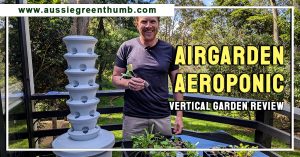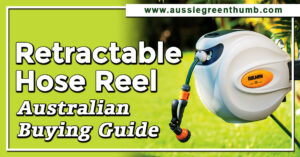Of all the worm farms you can build into your garden, none are as elegantly invisible as the Subpod. Forget laying up, and feeding worms with bedding, or draining worm tea fertilisers every week, the Subpod makes it easy.
In this basic guide to one of Australia’s most innovative garden products, we will dive deep into what is going on underground with the Subpod, and make sure you can make the most of this magical underground compost box.
More...
What is a Subpod?

Source: Subpod
A Subpod is an in-ground compost system that harnesses the power of the humble worm. Made from durable and long-lasting polypropylene, the boxes are designed to last for years so are an instant way to add long-term waste reduction systems to your garden.
Subpods have even perforations all over their casings, with rigid supports to keep the weight down but maintain their rigidity over time. This means that they can be buried in the ground, or in raised beds, and are even strong enough to be used as garden seats and perches to work around your beds with.
Subpod’s Brand
Subpod was invented by a team of passionate Australian gardeners in 2017, and their brand has just grown and grown since. Their aim was to make composting easy and to encourage more of us to do it.
Thankfully, it worked, and now their range of in-ground worm farms is one of the most popular compost systems in the country, with a growing reputation around the world.
How Does the Subpod Work?
The Subpod works by encouraging worms to break down your food scraps. It is no different to a typical compost bin in that respect, but it has one key difference.
Because Subpod is set into the ground, or surrounded by soil in raised beds, it is insulated. In summer, this prevents it from overheating, and in winter, it prevents it from freezing, meaning you can compost successfully every single day of the year.
That regulated temperature also makes it a more reliable home for the worms that are doing the hard work for you. The alternative, worm towers, can freeze and potentially kill worms, and in the heights of summer, they can get so hot that your worms completely give up and your compost stagnates.
Use this discount code at the Subpod checkout to receive 10% off your entire order: AUSSIEGREENTHUMB
Subpod Compost Bin and Worm Farm

Source: Subpod
Having spent decades exploring compost systems, and perfecting traditional composting to a fine art, I have to admit I have a bit of a chip on my shoulder about Subpod. It feels like cheating, because it shouldn’t work, but it does.
There is no turning, no overheating, and no aeration problems. It just creates a really good, usable compost, rich in worm castings, and everything us gardeners have spent our lives working towards just seems silly, because it’s so incredibly convenient.


Get Your Free Guide:
Master Growing Australian Natives eBook
A Must Have Complete Guide for Every Australian Garden
Get Your Free Guide:
Master Growing Australian Natives eBook
A Must Have Complete Guide for Every Australian Garden
The compost it creates is fine, moisture retentive, and beautiful to work with. It is richer than typical worm castings because it does not drain in the same way. That means you can use it just like any other compost – but should avoid starting seedlings directly in it if possible.
Subpod’s Downsides:
The only thing I would mention as a potential downside of the Subpod systems, is that the compost is not particularly adaptable. With traditional compost you can throw anything and everything on the pile whenever you like, and speed the process up by turning.
Because the Subpod is entirely reliant on worm activity for composting, you need to add your waste to it slowly. It is ideal for kitchen waste and dry leaves or grass clippings but for larger gardens, you are always going to need a bigger, traditional, compost pile, to manage all your garden waste properly.
Ways to Adapt Your Subpod
Subpod does not come in one single size. There are plenty of ways to adapt your Subpod, whether it's with the Subpod mini (perfect for smaller gardens) or a variety of raised beds that make composting easy in any garden.
Below, we will run through a few clever ways you can adapt your Subpod with existing products that are sold in clever bundles with the Subpod classic, or Subpod mini.
Subpod Grow Bed Bundle
The Grow Bed Bundle for Subpod composters is really easy to set up, even on hard ground. It is a simple steel raised planter that gives a little bit of space around your Subpod.
Not only does it make the Subpod easier to manage by raising it above ground-level. It also means you can plant up gorgeous decorative plants, and any worms you add to the Subpod are always nearby, ready to churn your kitchen waste into rich plant food for the adjacent crops.
Subpod Modbed, Raised Bed Bundle
For the Subpod mini, there is an even wider range of possible adaptations, including a raised planting bed on a stand. Ideal for balconies or paved gardens, and it even comes with castors so it can be moved around with ease.
Like all the Subpod kits, it includes an aerator to liven up your compost if you have left it too long, or it gets too wet. Plus, the Modbed has optional extras like greenhouse covers and netting or trellis.
Use this discount code at the Subpod checkout to receive 10% off your entire order: AUSSIEGREENTHUMB
How to Use a Subpod Compost Bin and Worm Farm

Source: Subpod
Subpods are simple to install and use. Dig a hole, pop it in, and start filling it with kitchen waste. That really is about all there is to it. Maintaining a well aerated Subpod is simple. Just add waste to it little and often, rather than in big bulks.
If your Subpod’s contents ever look damp, or smell anaerobic, use the tool provided to mix it up and get air down to the base.
What to Add to Your Subpod
Firstly, you will need to add worms. It might sound silly, but if you want to kick-start your Subpod’s composting power, adding red wigglers or any other sort of compost worm is the best way to do it.
Over time, a Subpod buried straight into the ground will attract its own worm population, but it is an absolute must to add worms to any Subpod compost bin in a raised bed or Modbed.
After that, you can compost anything you would usually compost at home, with a focus on kitchen waste for the richest blend of compost possible.
Once the worms are in, you can feed your Subpod with a mix of vegetable waste (uncooked, paper, and any organic materials other than fats and faeces (cat and dog poo are fine for a basic mulch, but toxic if composted and used on veggies).
Frequently Asked Questions About Subpod Gardens
How much food waste does a Subpod compost?
Subpods can compost up to 15kg of kitchen waste per week, which is more than any other type of comparably sized worm farm. The product is different, but the speed is really pretty impressive.
How many Subpods for an average family?
One Subpod classic (the larger model) is more than sufficient for an average family with two or three kids. For a couple without kids, the Subpod mini will be enough for all your kitchen waste.
Can I compost with Subpod in winter?
Probably the most important thing for gardeners to consider about Subpods, is that they can compost in the depths of winter. The insulation around them, from the earth or raised beds, means they maintain an ideal composting temperature all year round.
Do you need to add worms to a Subpod?
Subpods will attract worms naturally from your garden if they are dug into the ground. However, it can take a few weeks or even months to get enough worms in your Subpod for the most efficient composting. Adding compost worms from the beginning will speed up the process.
How do you harvest compost from a Subpod?
There are two ways to harvest compost from a Subpod. One is to leave it for two weeks without adding new materials (this is best done by dividing the bin in half, encouraging worms to move to the newly fed half), then digging out the drier materials.
The other is to dig the whole contents out and leave it in sunlight. Worms will head to the bottom, and you can use the higher compost after about five minutes.
Are Subpods made from plastic?
Subpod compost systems are made from Polypropylene, a form of plastic. The benefit of Polypropylene is that it is durable and long-lasting, so despite not being a renewable or degradable material, it will reduce the carbon footprint of your garden over time.
Make Composting Easier by Getting a Subpod Today
Subpods are fantastic composting tools, devised by a dedicated team of passionate gardeners. While they are not a direct replacement for traditional composting, they are the most effective and contemporary solution for anyone who wants to try worm composting at home, especially in warmer parts of the county.
They work in large gardens, small gardens, balconies, and even paved spaces with no soil at all. Thanks to that, Subpods are perhaps the most adaptable compost systems in existence, and they originated right here in Australia.
Published on January 2, 2024 by Nathan Schwartz
Last Updated on October 4, 2024





I am after a tumble compost bin, delivered to Norfolk island, but cannot find any on your website
Hi Craig,
Thanks for reaching out!
While we don’t have them listed on our website directly, I reckon you’d find some great recommendations over on our article about the best compost bins in Australia.
Best regards,
Gary Clarke